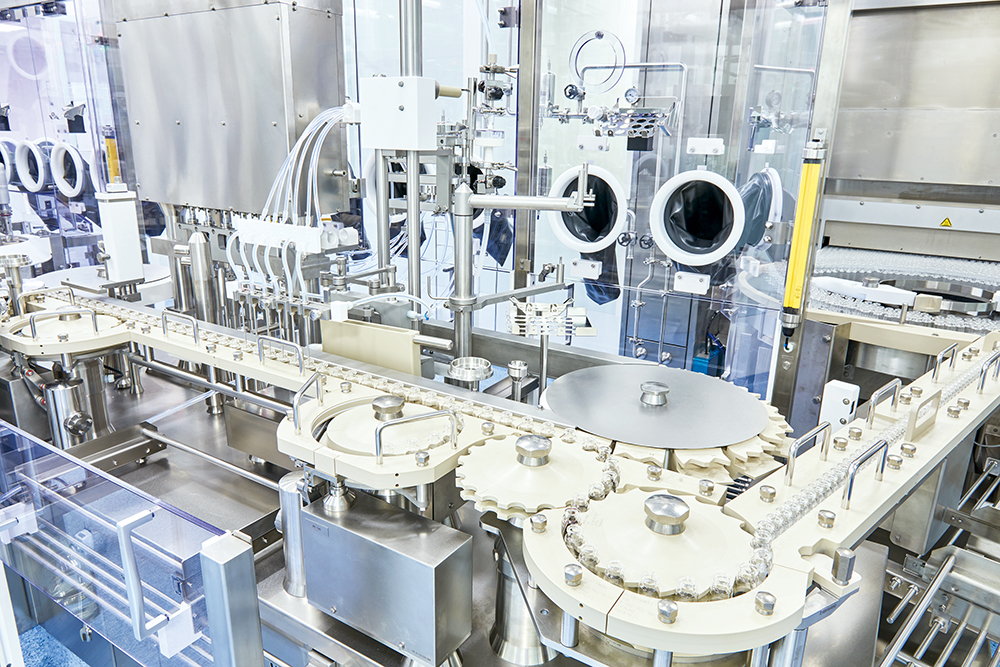To Issue 152
Citation: “Interview with Jeff Henderson, Vetter”. ONdrugDelivery, Issue 152 (Oct 2023), pp 134–136.
“Using CDMOs to get products to clinic and achieve effect commercialisation can make the much-needed income to fund future drug development efforts.”
Q Can you give use an overview of the role Vetter plays within the pharmaceutical industry?
A Outsourcing in the pharmaceutical industry is anticipated to rise considerably between 2023 and 2030, according to the Pharmaceutical Outsourcing Market Insights Report 2023. Growth is projected to continue as more and more pharmaceutical and biotech companies develop strategies around the adoption of outsourcing.
Vetter is an experienced CDMO with a proven track record of supporting clients from the early development phases through commercialisation and lifecycle management (Figure 1). With tried-and true experience with biologics and sensitive compounds, Vetter uses state-of-the-art technology and efficient processes and strives to put its customers a step ahead of the competition. To do this, Vetter lays a foundation of scalability, quality and sustainable value for drug products.
However, whether a customer works with a CDMO such as Vetter or not, every pharmaceutical drug developer must consider whether to outsource or insource the manufacturing of a drug product. The best strategy for one is not necessarily the best strategy for all.

Figure 1: Vetter has extensive experience operating as a tried-and-true pharmaceutical CDMO.
Q In your experience, what elements of a drug product’s development does the biopharma industry most often outsource?
A The most common services that drug developers choose to outsource to CDMOs vary between development and manufacturing. However, we most often see outsourcing for drug substance manufacturing, drug product manufacturing and device assembly. Because delivery devices can be very complex to assemble, it can require a deep level of technical, operational and regulatory know-how that many small biotech companies do not have. Rather than develop an entirely new knowledge base that may be costly to acquire, companies outsource to partners to leverage their robust, efficient and scalable processes, which can often integrate seamlessly into already established aseptic filling programmes.
Big pharma companies will use a total cost of ownership model to decide what makes the most financial sense tooutsource versus keep in house. Smaller biotech companies generally outsource based on necessity, due to a lack of required infrastructure, supply chain access or staff. Developing and manufacturing a drug product is an extremely complex process and one that requires extensive expertise, which is not common in a small or start-up drug development team outside of a specific niche.
The process of second sourcing allows smaller companies to build internal capabilities to manage risk through outsourcing. While a large pharma customer likely won’t need to outsource production of its blockbuster drug, a smaller-scale company may need to take on the risk for the sake of meeting quality needs and timeline requirements.
“To keep up with rapidly evolving technology, drug sponsors can outsource to CDMOs with state-of-the-art infrastructure, rather than acquire new specialities on their own, which are expensive, before a drug product produces any income.”
Q What will be some of the key trends of pharmaceutical outsourcing for the next 12 months?
A We’re seeing that big pharma is generally focused on drugs that move the needle of total revenue. Since these blockbuster drugs are often a company’s primary output, they rarely have a need to outsource. However, new products are sometimes outsourced for the flexibility that contract partners can provide.
Alternatively, small biotech companies may lack in-house capability, even if it’s the only drug product in development. This could be caused by a lack of staff, infrastructure or supply chain access. Using CDMOs to get products to clinic and achieve effective commercialisation can make the much-needed income to fund future drug development efforts.
Q Considering that companies can outsource at any point in the drug development process, what are the key outsourcing strategies that you think the biopharma industry should be adapting?
A During and after the covid-19 pandemic, it became evident that there is always a risk to the stability of manufacturing and supply chains. The result of recent bottlenecks, which are still ongoing, has been a shift towards companies across many industries going directly to partners to build more robust and reliable supply chains. However, that effort is easier said than done – it takes time, money and resources to develop a truly comprehensive and accountable supply chain. Outsourcing can be an extremely effective strategy here, whether during clinical development or at any time throughout the manufacturing process. The lack of a supply chain can impact the entire drug development process but can be mitigated with outsourcing.
Another major outsourcing strategy that biopharma companies are taking relates to new technological requirements, which is evolving at a rapid pace, particularly as the world experiences a technological transformation. To keep up with rapidly evolving technology, drug sponsors can outsource to CDMOs with state-of-the-art infrastructure, rather than acquire new specialities on their own, which are expensive, before a drug product produces any income. New modalities require outside agents to help customers produce on a fast timeline and within a set cost. As the outsourcing market grows, CDMOs face heightened scrutiny, which requires pristine reputation management. Our commitment to quality allows us to build a lasting trust with our customers that equips them to engage us with their fragile biologics.
Q How can customers mitigate their risk when outsourcing?
A Drug developers can take several steps to mitigate the risks associated with outsourcing. Using second or multiple sources is a reliable way for pharma or biotech companies to leverage external expertise and capacities in areas they may not currently be equipped for themselves. Having multiple supply chains enables drug owners to maintain access to the products, chemicals and materials needed to get their drug product from Phase I to commercialisation without unplanned delays.
Also, retaining a CDMO to hold capacity and maintain flexibility may serve as an insurance policy to support bringing a drug product to market despite the constant risk of external hurdles. While complex and costly, it is well worth it in the end. Work with one CDMO source and learn from the process. Take account of key findings at the end of the launch management process and implement them into all future outsourcing relationships to build on past trials and successes. Once one drug product successfully reaches the market, the income will make outsourcing easier for the next product.
“We continue to make investments in our capabilities and production sites, which further proves the value we can bring
to our customers.”
Q Are there any new technologies that are requiring greater outsourcing?
A While it’s not a requirement, we are witnessing a massive shift to digitisation in the pharma and biotech industries. As a result, we are incorporating new technologies that our customers may not have access to. For example, “HelMo” is a mobile robot that we are using to standardise and optimise routine tasks, such as thawing drug substances. Our ability to save human capacity from routine work enhances our ability to manufacture our customers’ drug products in an even more efficient timeline than what they could do in-house. By outsourcing, customers leverage CDMO capabilities that are often cutting edge and outside the scope of internal expertise within a drug company.
Q What are the main reasons an internal task should be outsourced in development and manufacturing?
A Reasons to outsource vary greatly based on individual drug product development and manufacturing strategies. However, there are several primary reasons that we see a customer decide to outsource during the process. One is risk tolerance – if a drug development process fails, the cost can be detrimental to a drug company, especially small or start-up companies. Working with a tried-and-true CDMO partner can prevent risk that may be too costly to handle. Then there’s internal capacity, which can relate to plant, people or expertise. If the infrastructure, staff or knowledge required to develop a drug are not available in-house, it is best to outsource to a partner who has all three capacities.
Another factor is speed to market or clinic, which is critical as a drug product does not generate profit until it reaches the market. As a result, working with a partner who can expedite the speed of development to commercialisation can be a worthwhile investment. Commensurate to this is the cost to produce a drug product, which can be immense and often outside the scope of a smaller developer. Partnering with a CDMO can be a more reasonable investment that achieves the same or better result.
Lastly, companies must consider the quality of the product that they bring to market. Drug developers must adhere to exceptionally strict regulations and quality standards. Vetter boasts in-depth knowledge of regulatory requirements that support the level of quality required to get a product to the patients who need it.
Q For organisations that keep production and manufacturing in-house, why is this the case?
A More often than not, organisations who keep all drug product development and manufacturing in-house do so because of a previous negative experience. They are likely faced with two major concerns – “Do we have the technology to develop our drug product?” and “Do we have enough capacity?” The lack of one or both of these factors has caused a decade-long boom in the use of CDMOs that can fill these gaps. We continue to make investments in our capabilities and production sites, which further proves the value we can bring to our customers (Figure 2). The connectivity between CDMOs and the larger industry also allows customers to keep their finger on the pulse of industry needs and expectations without expending limited internal resources.

Figure 2: Vetter’s production sites make use of state-of-the-art technology and efficient processes.
To address the concern of lack of control when outsourcing, customers can establish and define quality expectations and agreements in initial contracts and through ongoing audits throughout the duration of the partnership.
Whether a drug company outsources for one major component of its drug development process – often including drug substance manufacturing, drug product manufacturing or clinical trial management, or the entire process from Phase I to commercialisation – there is value in leveraging external capacities. Incorporating the knowledge, skillsets, workforce, infrastructure and connections of a CDMO with proven success is a smart and effective business decision for large and small pharma and biotech companies looking to bring their drug product to market.
To find out more about Vetter’s solutions, visit: www.vetter-pharma.com.

